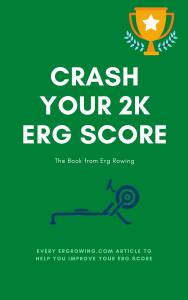If you are a rower, it would be a good idea to do some erging during the summer rowing season. Even if it’s just 1 erg session per week it can really benefit and help your rowing.
Erging in Summer will help you
- Keep in touch with the erg for the following winter
- Row some fitness boosting workouts without having to rely on a crew.
- Extract a maximum rowing related workout from yourself – without worrying about rowing crew technique.
- Get some extra rowing sessions in (good if you are looking to get an edge over your rivals and are involved in a seat-racing or selection scenario)
All of the following workouts are designed to be short and hard. In summer the priority should be with your on – water rowing sessions. But if you feel you need to erg for any of the reasons above, it would be better if you could just get a quick, effective session in without adversely affecting your crew rowing.
But the thing is – you need to be able to judge this for yourself. And it depends on lots of factors.
Here are some things that you should consider:
- Your current training load (and how tired you are)
- Your overall fitness base (and ability to recover from extra sessions)
- Your time – and the priority you give to rowing or erging
- Your rowing technique – some people believe that erg can affect your rowing boat technique in a negative way. This is an important consideration if you are a novice or are less experienced rower. Beginner rowers’ rowing technique can be more impressionable and open to influence.
The last point is very important. Say you have spent the past 5 weeks learning how to load your legs in co-ordination with your back and arms. Then you get on the erg and hammer out 5 x 500 meters (causing you to pull and jerk your shoulders at the catch) – you could set yourself back a long way in terms of technical development.
In summer, rowing coaches pay close attention to rowing technique.
But it’s not really a big problem for more experienced rowers – they can usually hold their technique regardless.
Here are the workouts.
Summer Rowing Session #1
- 8 x 500 meters / 1 minute rest
- Do 8 times 500 meters with a 1 minute rest.
- Aim for a consistent average erg score.
- You can vary the intensity using average power or rating.
- Or, if you are feeling really good, extend the session to 10 x 500 meters.
Summer Rowing Session #2
- (16 strokes hard / 5 strokes light) x 15
- Row hard for 16 strokes (this is 30 seconds if you are rating 32 strokes per minute)
- Row light for 5 strokes (15 seconds of you rate 20 strokes per minute)
- Repeat 15 times
Again you can vary the intensity using rate and power. A higher rate will obviously make the work phase shorter.
If you are feeling Olympic, you could take a 5 minute rest after the 15 repetitions and repeat the whole set again.
Summer Rowing Session # 3
- 3 x 1000 meters (rest time: same as your work time)
- This session is great and one of the best (in my opinion) for summer rowing training.
- The session is based on the erg workouts that boost your Vo2 Max article and you should read it for more details.
Important. For all the workouts, you should warm up well (as you would for any hard rowing workout). Also bear in mind the timing of the session. If you are using the erg to get ahead and do some extra sessions by yourself make sure you do them when they will least affect your actual crew rowing sessions.
The best time to do them is when there is no rowing seat racing imminent. And you know you will have plenty of time to recover for the next important crew rowing session. I stress important here, because you need to decide which crew rowing sessions are important.
Related Articles
1. Crash Your 2k Erg Score Test Strategy
2. How To Mentally Prepare For A 2k Erg Test
3. Boost Your Middle 1000 Meters with This Rowing Workout
4. 7 Steps To Seriously Effective Erg Technique
5. 2k Erg Test 7 Day Taper Plan
[mc4wp_form]
Want More Erg Rowing Insights?
Subscribe to get notified immediately about new posts.
Introducing the 2K Erg Book

See Book Chapters
9 Chapters full of the best articles from ergrowing.com
